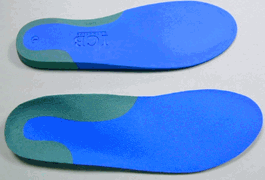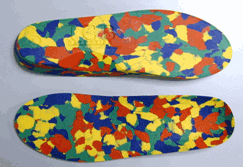 |
Believe every kid has infinite potential
to play, to move, to learn, and to blossom!
|
|
|
|
|
|
| |
Services

- Paediatric Physiotherapy
- Neuo-Sensori-Motor-Developmental Assessment (NSMDA)
- Sensory Integration
- Craniosacral Therapy
- Tailor-made ICB insoles
- Baby Massage
(By appointment only)
Paediatric Physiotherapy
Important factors for your children to grow healthy
Sensory and motor developments are the underlying foundation for all future progress. Babies learn through interaction with their environment. In order to do so, an infant must have the abilities to sense, to feel, and to move freely and purposefully. Sensory and motor development affect the child’s ability to explore the surroundings, to turn his/her head in order to follow a moving object with the eyes, to reach and to grasp toys, to crawl, walk, run, climb and jump, etc.. These physical, interactive activities foster understanding and mastery of the environment, stimulating cognitive, language and social development.
How can Paediatric Physiotherpist help your kids?
Paediatric physiotherapy is holistic in nature to treat the whole child in order to facilitate the child’s physical and mental growth, general health and well-being, but not just the body in isolation. A paediatric physiotherapist helps to maximize a child’s sensory and motor function; to stimulate optimal physical development and physical fitness; to facilitate independent self care and daily living; to encourage participation in physical activities, so as to enhance better self-image, self-esteem and self-confidence.
Physiotherapy assessment and training are based on up-to-dated evidence with well-known theoretical framework such as, Neuro-sensory-motor-developmenntal Approach (Yvonne Burns 1979, Pauline Watter, 1987) ,Sensory-Integration (Jean Aryes, 1972) and Neurodevelopmental Therapy (Bobath, 1964). Treatment involves facilitation of gross and fine motor development, enhancement of sensory-motor integration, postural and movement control, strengthening, balance, physical fitness training, massage, mobilization, stretching, strapping; and prescription of orthosis, orthotics and special needs equipments, etc. Whatever techniques are used in therapy, enthusiastic parental involvement at home is essential for optimal long term results.
Peadiatric Physiotherapist can help Babies or children with:
- Delay gross and fine motor development (e.g. dislike being placed on his/her tummy at 5 months old and does not appear to push up with arms; never crawl but shuffles on his/her bottom or cannot use the thumb and index finger to grip at 12 months.)
- Over-responsiveness (irritable, restless, irregular sleeping pattern)
- Under-responsiveness (does not react, sleeping too much)
- Hypotonia or low muscle tone (poor head control, floppiness in his trunk or limbs, slump back, W-sitting, poor walking endurance)
- Hypertonia or high muscle tone (e.g. stiffness in the legs, typically noticed during nappy changing, or your child may like to be held up in standing just too much)
- Prematurity
- Downs Syndrome
- Cerebral Palsy
- Hydrocephalus
- Brain injures
- Spinal Bifida
- Developmental Coordination Disorder (clumsiness and coordination problem with examples of messy eating, poor ball skills, poor balance, awkward running pattern, difficult in learning new skills)
- Specific Learning Disability
- Attention Deficit Hyperactive Disorder / Attention Deficit Disorder (ADHD/ADD)
- Autistic Spectrum Disorder
- Sensory Integration Disorder
- Torticollis (favour of Turning head to one side; irregular head shape-plagiocephaly)
- Erb's Palsy
- Inturning feet (Talipes Equinovarus) or out-turning feet (Talipes Calcano Valgus)
- In-toeing or out-toeing walking pattern
- Flat Feet
"Paed physio check"
Frequently a (sensory motor developmental assessment) for your baby or child may simply help to put your mind at rest. . Even minor ailments can become habitual and eventually difficult to change. It is never too early to seek help, advice and, if necessary, physiotherapy treatment. Generally the earlier therapy starts the better!

Neuo-Sensori-Motor-Developmental Assessment (NSMDA)
The NSMDA has been devised by Burns and Watter (1974) and revised for use with children with DCD by Watter and Bullock (1979) and Watter (1984). The items for assessment were grouped into eight major neurological areas, including visual motor, reflex activity, orientation and postural reactions, proprioception, spatial or vestibular function, tactile, gross and fine motor areas.
Watter and Bullock (1987) reported improvements on the Neruo-sensory-motor Developmental Assessment (NMSDA) that were maintained at 6-month follow-up after a 6-month developmental physiotherapy programme. The children underwent 10 minute home exercise programme for four times weekly. Also, each child received individual monthly physiotherapy treatment to review and update the programme.
84 children with DCD underwent a physiotherapy directed school based group programme for three times per week for 15 to 20 minutes. 50 children showed significant improvement after three months, where the remaining children needed six months to show improvement.(Watter and Bullock, 1989).

Sensory Integration
Our sensory systems detect sights, sounds, smells, taste, pain, temperature, pressure, position and movements of our body. Most people coordinate all this sensory information in a process called sensory integration to help form a complete understanding of the environment and respond accordingly. Sensory integration typically begins during gestation and develops through life.
Sensory integration disorder is usually evident at a young age. When sensory integration dysfunction occurs, the ability to distinguish and adjust to various sensations is disrupted, resulting in poor motor planning. Inappropriate behaviour among children inevitably interferes with social interactions, emotional skills and self-esteem. Some symptoms of sensory integration disorder include hypersensitivity or undersensitivity to sensory experiences, inability to self-regulate emotions, apparent clumsiness and difficulty adapting to new situations.
Treatment for sensory integration is designed for individual children by controlling the sensory stimuli. More challenging sensory activities are presented as the child successfully overcomes each stage of difficulty. An effective sensory integrative approach will help the child organize and respond to the environment in more adaptive ways.

Craniosacral Therapy
Craniosacral therapy (CST) originated from the American osteopath, Dr. William Sutherland, in the 1900s. Its rapid worldwide expansion is largely thanks to the dedication and work of John E. Upledger who founded the Upledger Institute in 1985 to teach CST.
The craniosacral system is composed of cerebrospinal fluid enclosed by cranial meninges which also extend down the spinal canal anchored by bony attachments. As cerebrospinal fluid circulates in and out of the craniosacral system, it creates a physiologic pulse similar to the cardiac rhythm. This craniosacral rhythm travels along the interconnected fascia to all parts of the body. Trauma to the craniosacral system may cause dysfunction and inhibit range of motion.
CST is a delicate, noninvasive technique that releases restrictions and restores the natural craniosacral rhythm, allowing the entire body to heal.
What conditions does craniosacral therapy help?
Wide-ranging conditions can often be helped such as:
- Anxiety, Depression, Emotional Difficulties
- Brain and Spinal Cord Injuries
- Central Nervous System Disorders
- Chronic Pain Syndromes
- Digestion problem
- Facial Pain
- Headaches/Migraines
- Healthy Baby/Healthy Mother Programs
- Insomnia (sleep disorder)
- Jaw Pain and Temporomandibular Joint Dysfunction (TMJ)
- Menstrual pain
|
- Neck and Back Pain, Sciatica
- Orthopedic Problems
- Post Traumatic Stress Disorders
- Recent Injuries
- Rheumatoid Arthritis
- Scoliosis
- Sinusitis
- Stress and Tension-Related Problems
- Tinnitus
- Vertigo
- Wellness Visits
- Whiplash
- and many others
|
How does CST help babies and children?
Since the craniosacral system has a direct impact upon the smooth functioning of the brain and spinal cord, it is easy to see how restrictions and tensions in these areas can create a multitude of motoric, sensory and neurological impairments in babies and children.
Research has shown that womb positioning and the birth process itself has a very strong impact on the central nervous system. Carried out in the delivery room or within weeks of delivery, CST can often reduce a wide variety of problems, many of which may not be noticed by conventional medicine until children start showing delays in their developmental milestones or reach their school years. School-age children can benefit greatly as well from regular craniosacral work. Even problems with head shape and skull-bone overrides can be corrected with the skillful use of craniosacral therapy.
Conditions such as the following can be helped with CST:
- Asthma
- Attention Deficit Hyperactive Disorder /
Attention Deficit Disorder
- Autism
- Behavioral Disorders / Emotional Problems
- Cerebral Palsy
- Colic
- Chronic ear infections
- Digestive/Elimination issues
- Down Syndrome
- Erb’s Palsy
- Eye-Motor Coordination Problems
- Failure-to-thrive syndromes
- Hearing problems
|
- Hydrocephalus
- Learning difficulties, Dyslexia
- Motor-Coordination Impairments
- Poor sucking
18. Reflux
- Scoliosis
- Sensory Integration issues
- Sleeping problems
- Speech delay
- Seizures
- Spasticity
- Strabismus
- Torticollis (only turning the head to one side)
- Vomiting
- and many others
|

Tailor-made ICB insoles
 
Customized Orthotics
The International College of Biomechanics developed and patented the Dual Density Heat Moulding Medical Orthotics. These durable insoles will retain their shape even over prolonged use and are made of bacterial resistant material which can be cleaned with tepid water. The orthotics are constructed to provide an ideal angle for walking, lend biomechanical support and re-distribute weight equally across the foot. Therefore, conditions that may benefit from orthotics include flat feet, in-toeing or out-toeing gait, bunions, heel spur, plantar fasciitis, as well as pain in the leg, knee, hip and back.
We offer economical personalized orthotics for children and adults.

Baby Massage
Across diverse cultures, baby massage is a tradition that is being re-discovered in developed countries. Touch is a universal form of communication, especially for babies who have yet to master language. Skin to skin contact is a powerful way for parents to express comfort and tenderness to their infants. Undivided attention and eye contact during massage also promote bonding – the foundation for a lifelong loving relationship between caregiver and infant.
We are Certified Infant Massage Instructors from International Association of Infant Massage. We offer massage for newborns up to one year old infants as a valuable way for parents to intimately connect with their babies. During each session, parents will learn to massage a different part of the body, progressing until the entire routine is learned.

|
|
|
|
Copyright 2011 | Kids Blossom Health and Development Centre | All Rights Reserved
|
|
 |
|